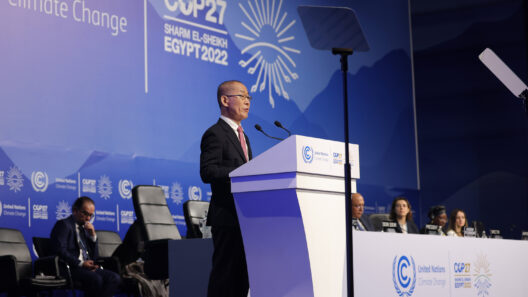In the intricate tapestry of life, there exists an unseen battle—a silent confrontation occurring at the very heart of our biological existence. As global warming escalates, it weaves a complex narrative that intertwines environmental shifts with cellular responses, shaping the future of all living organisms. While the effects of climate change often manifest as visible phenomena, such as extreme weather patterns or rising ocean levels, the true implications extend far deeper, encapsulating the molecular and cellular responses that underpin life itself.
Consider the cell as a miniature fortress, safeguarding its valuable components—DNA, proteins, and organelles—against external threats. The rise in global temperatures acts as an insidious adversary, infiltrating this fortress and destabilizing its carefully regulated environment. This invasion presents itself in various forms: increased oxidative stress, altered nutrient availability, and disrupted cellular communication. Each of these factors contributes to challenges that living organisms must navigate to maintain their health and functionality.
Oxidative stress emerges as one of the most pernicious consequences of climate change. As global temperatures rise, so does the prevalence of reactive oxygen species (ROS), unstable molecules that damage cellular structures. Like a slow-burning wildfire, oxidative stress engulfs cells, precipitating a cascade of damaging reactions. The imbalance between ROS production and the cell’s antioxidant defenses leads to cellular dysfunction, which can trigger a range of detrimental effects—from accelerated aging to increased susceptibility to diseases, such as cancer.
Moreover, the intertwined dynamics of nutrient availability and global warming introduce another layer of complexity. As temperatures climb, ecosystems undergo profound transformations; soil degradation and changes in precipitation patterns affect the nutrient cycle. This upheaval compromises the availability of essential nutrients required for cellular processes. Imagine each cell as a worker in a factory; if the raw materials are scarce or of inferior quality, the end products suffer, resulting in weakened organisms that are ill-equipped to face environmental challenges.
Cellular communication, too, suffers in this altered landscape. Cells communicate via chemical signals, much like a symphony where each instrument must harmonize to produce a magnificent auditory experience. Climate change disrupts this delicate symphony, primarily through the alteration of signaling pathways. For instance, hormonal signaling—which regulates growth, metabolism, and stress responses—can become dysregulated as the environment becomes increasingly hostile. Such disruptions can impair organismal resilience, leading to cascading failures throughout trophic levels in ecosystems.
The repercussions of these cellular-level changes extend beyond physiological health, permeating ecological dynamics. For instance, altered reproductive patterns in organisms can ensue due to disrupted cellular signaling. Species that rely on precise timing for reproduction, such as certain fish and amphibians, may find themselves out of sync with environmental cues. If the cell’s ability to perceive and respond to temperature changes falters, entire populations may dwindle, leading to loss of biodiversity and shifts in community interactions.
As these cellular battles unfold, they also challenge humanity’s relationship with the natural world. The consequences of climate change resonate through the food web, influencing agricultural practices, food security, and human health. The resilience of crops hinges on their cellular mechanisms to adapt to climatic stressors. If these mechanisms falter, food supply chains become tenuous, impacting millions across the globe. It is thus crucial to grasp the interconnectedness between ecological stability and cellular integrity, for both are inextricably linked.
Furthermore, the emergence of novel diseases highlights the urgency of addressing climate change. As habitats transform under the pressure of rising temperatures, organisms migrate, seeking refuge. In this upheaval, pathogens can exploit new hosts, leading to the spread of diseases previously unknown in certain regions. The underlying cellular mechanisms that govern immunity consequently become paramount in the face of these novel threats. Our understanding of cellular responses to environmental stressors will be pivotal in developing effective strategies for disease prevention and management.
As we delve deeper into the unseen battle against global warming, it becomes evident that the implications extend far beyond the surface. The health of our planet hinges on the health of its cells. Consequently, safeguarding cellular integrity necessitates an integrative approach—one that embraces environmental stewardship, sustainable practices, and a commitment to addressing climate change at its roots. Every decrease in carbon emissions, every effort to enhance biodiversity, and every initiative aimed at soil restoration contributes to the preservation of this delicate balance.
In conclusion, the changes wrought by global warming at a cellular level remind us that even the minutiae of life hold profound significance. Understanding these complexities offers a pathway to mitigate future challenges. As global citizens, we must acknowledge our role as stewards of life on Earth—an obligation to safeguard not just the visible world around us but also the microscopic battles occurring within. The fate of our ecosystems and our species ultimately resides in this intricate interplay, urging us to take action before the final notes of this symphony fade into silence.







